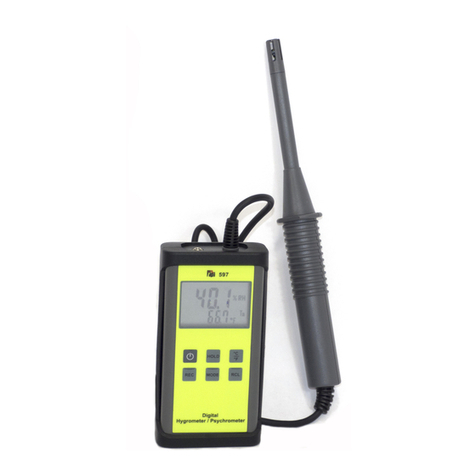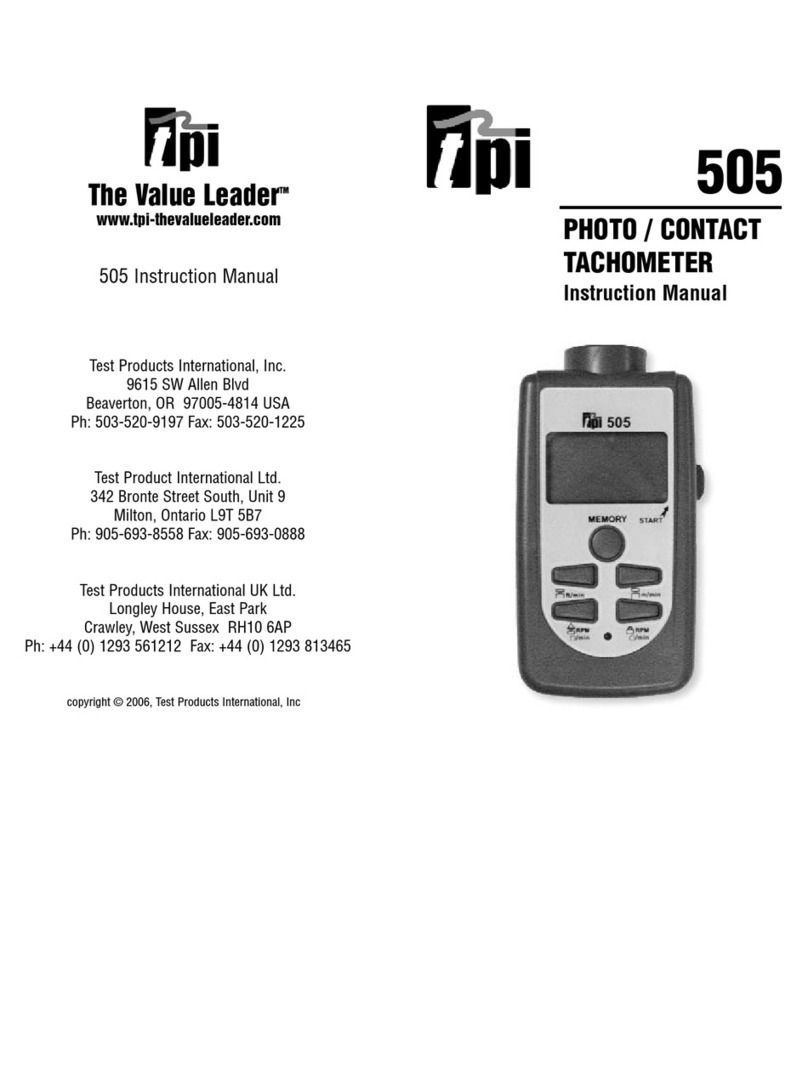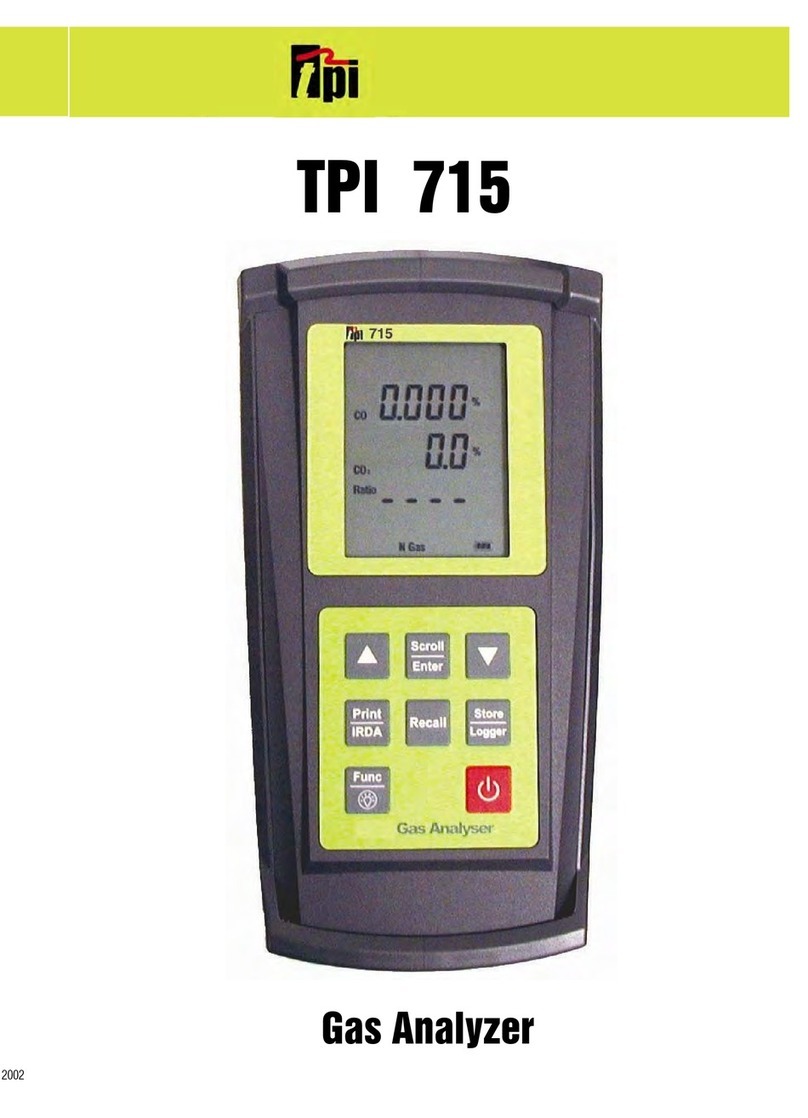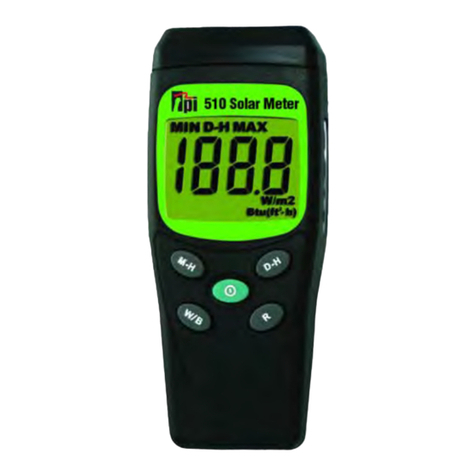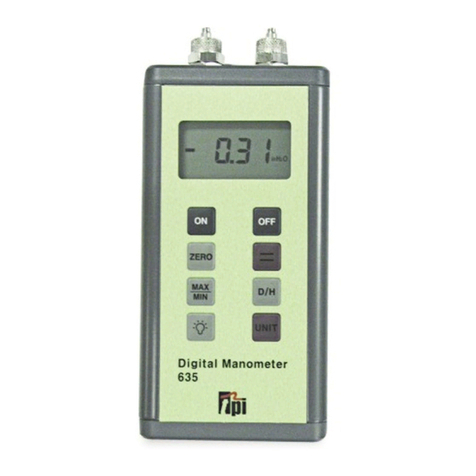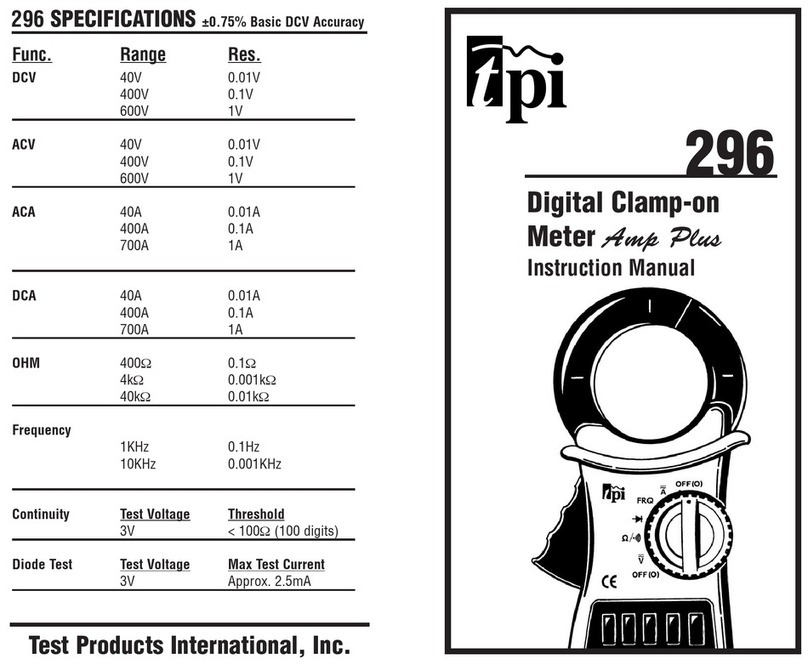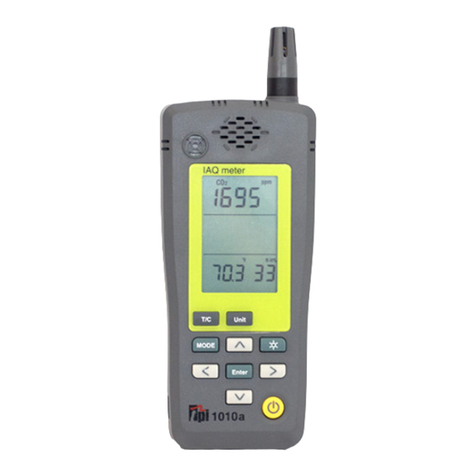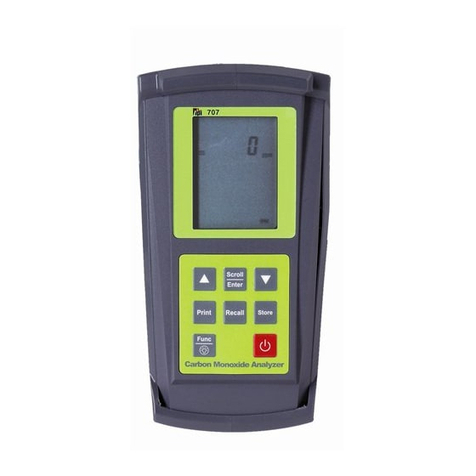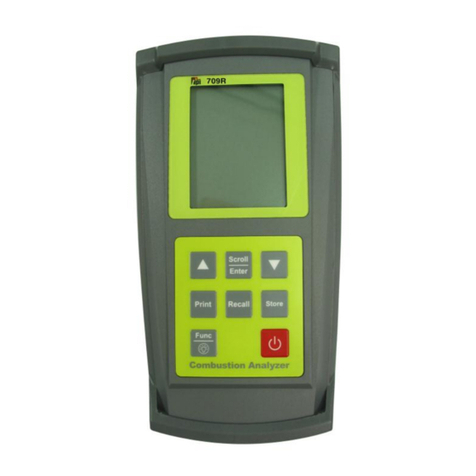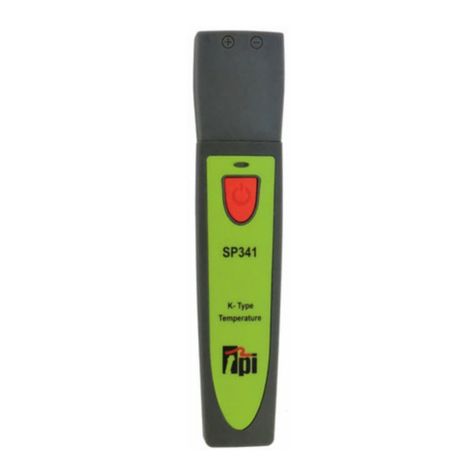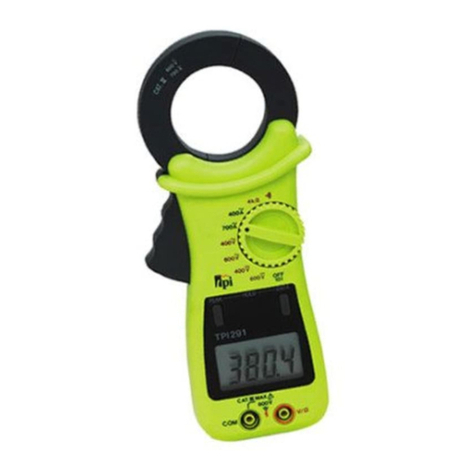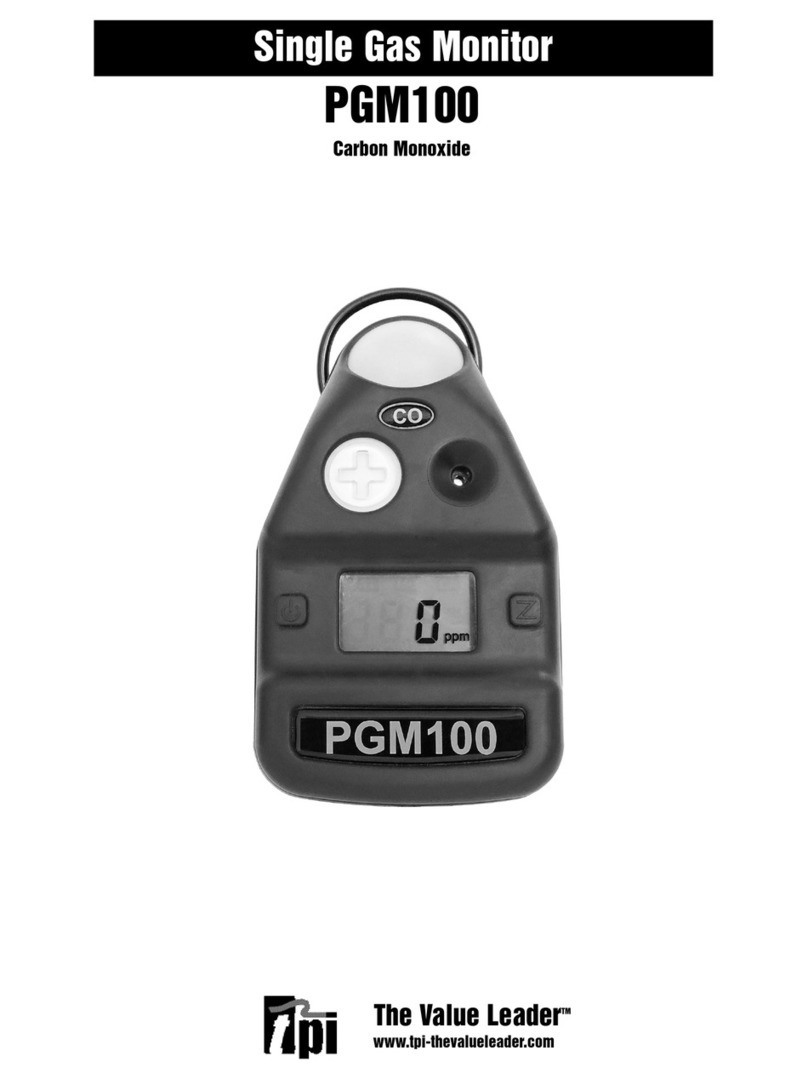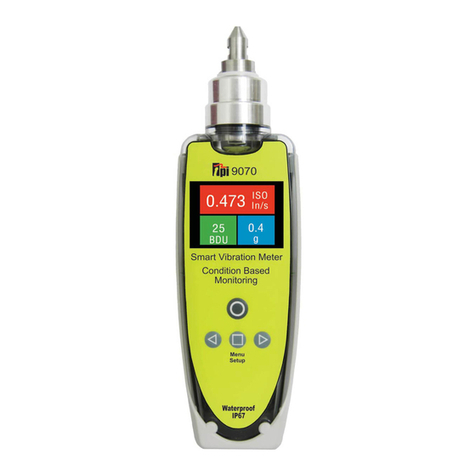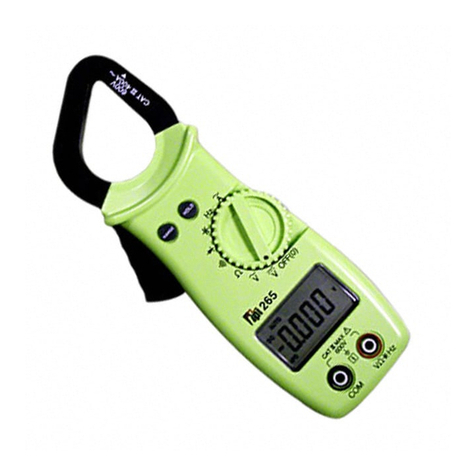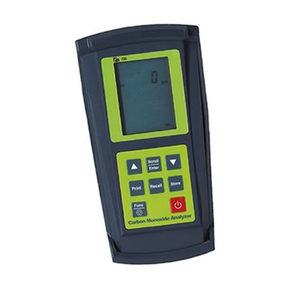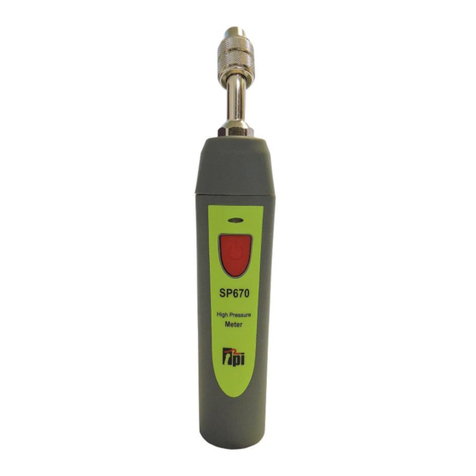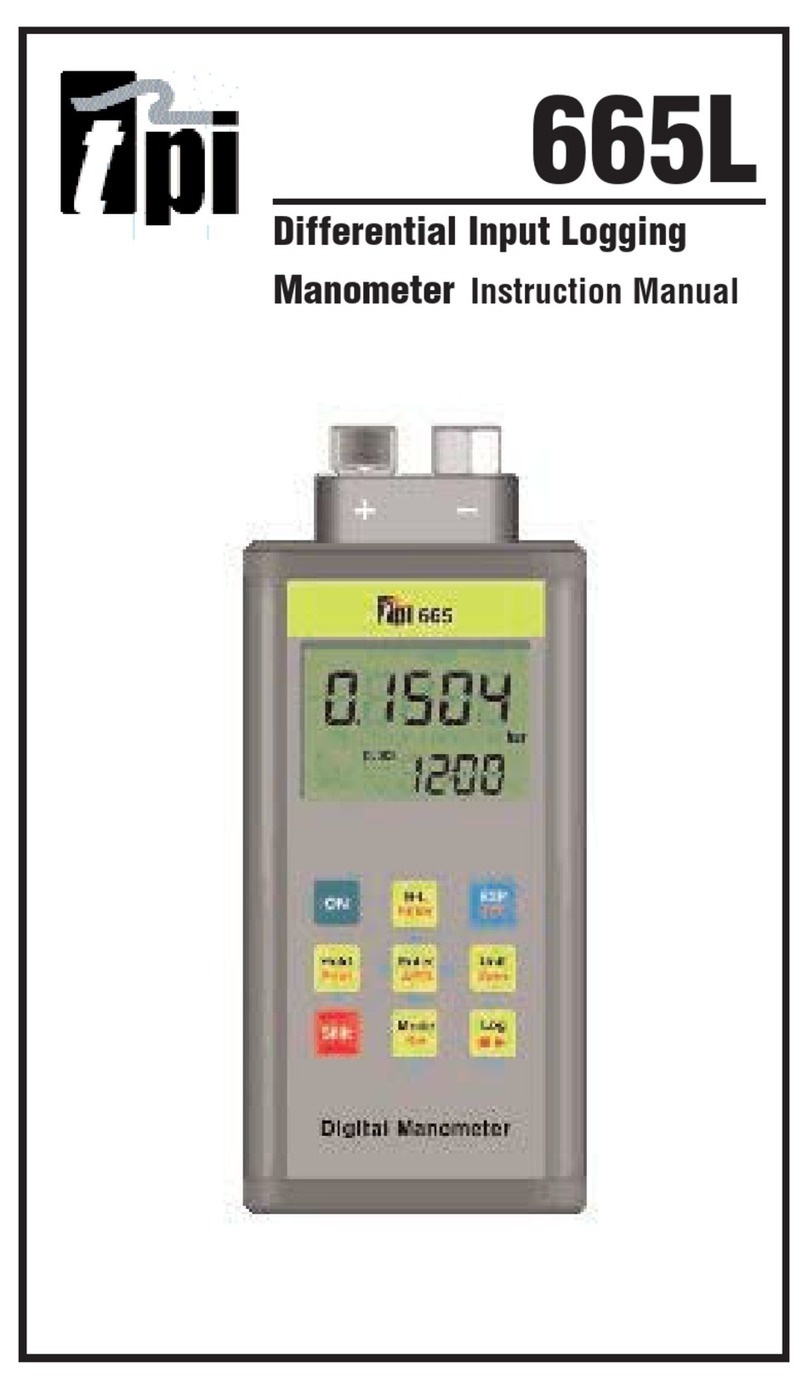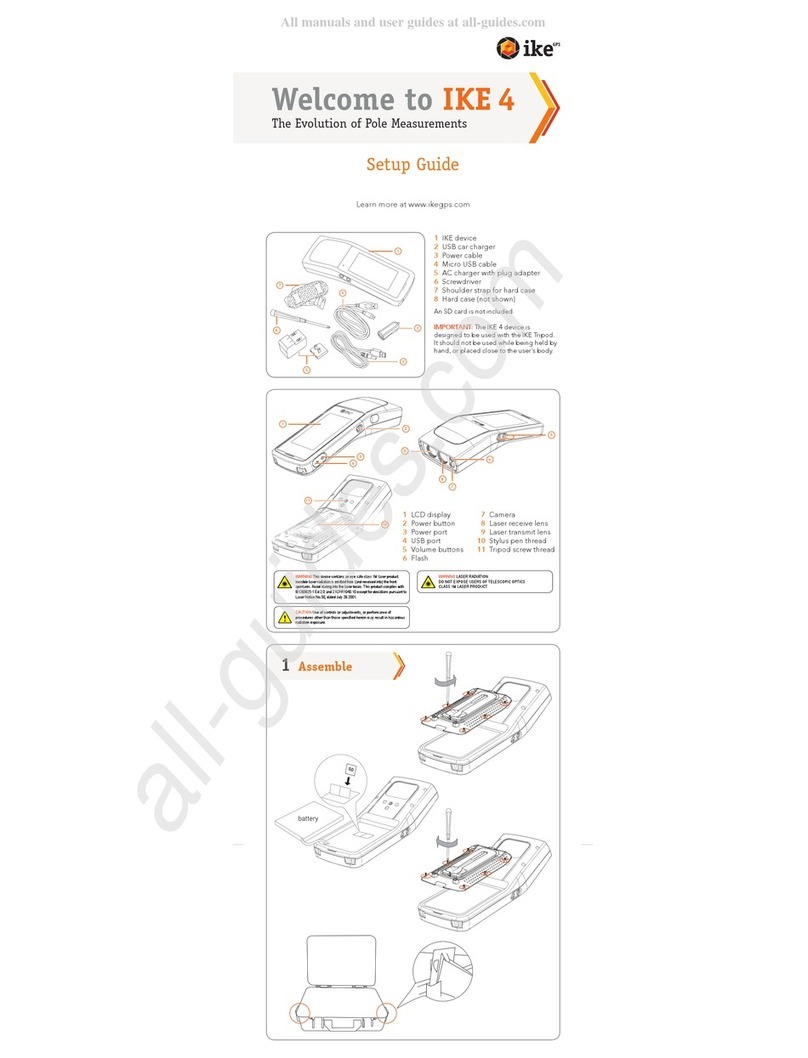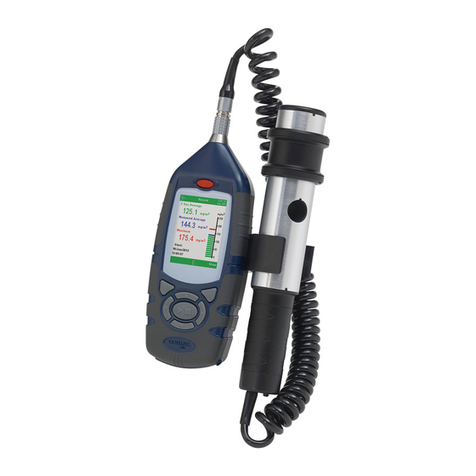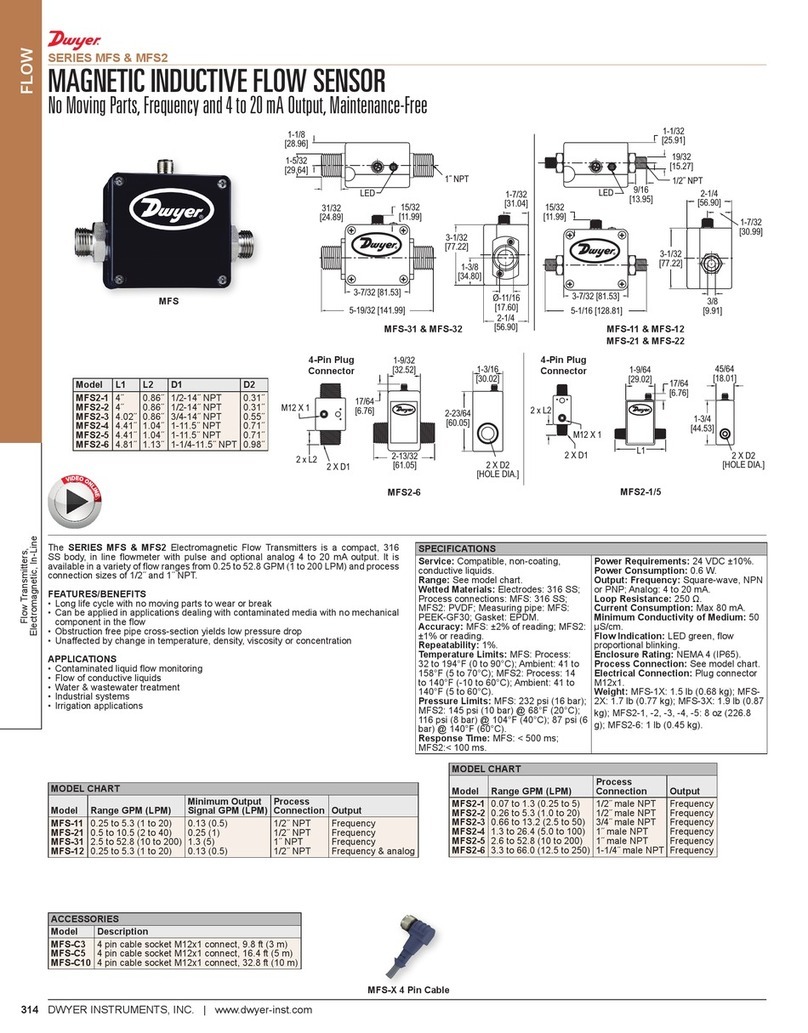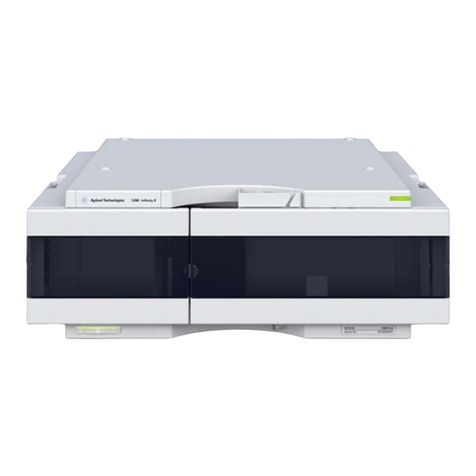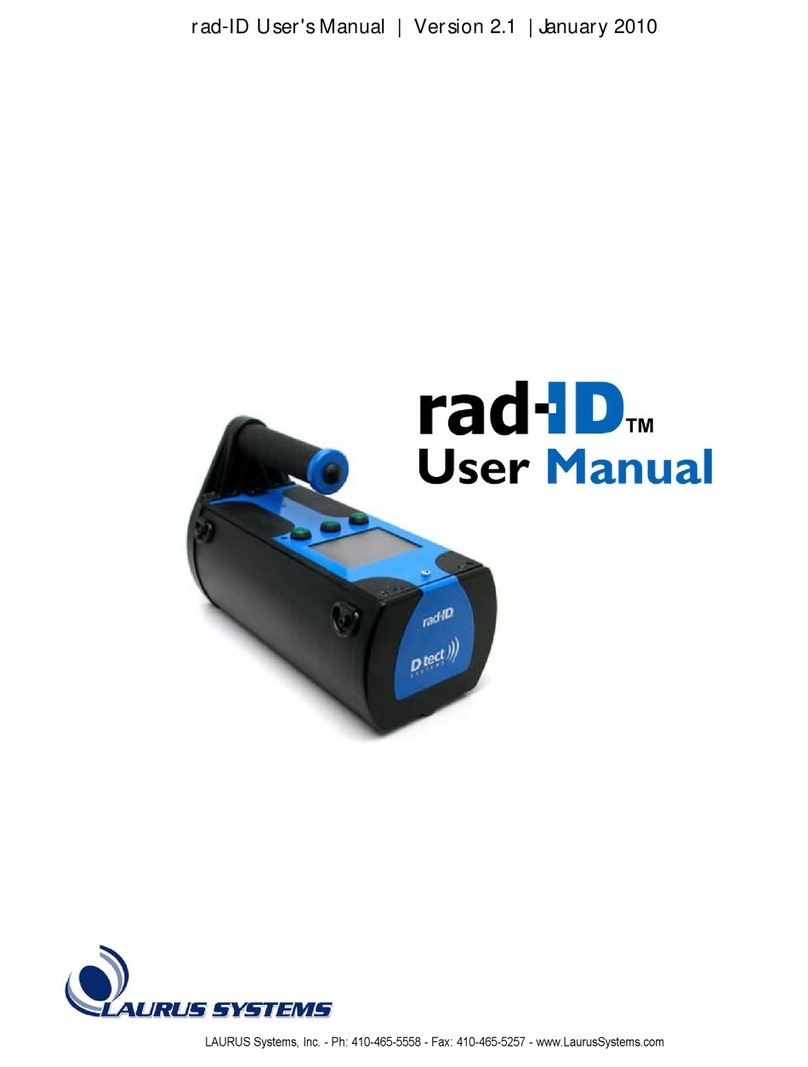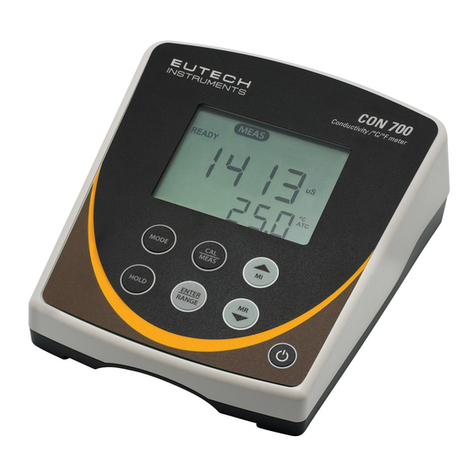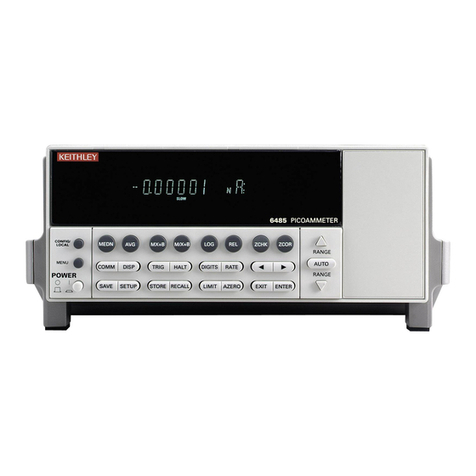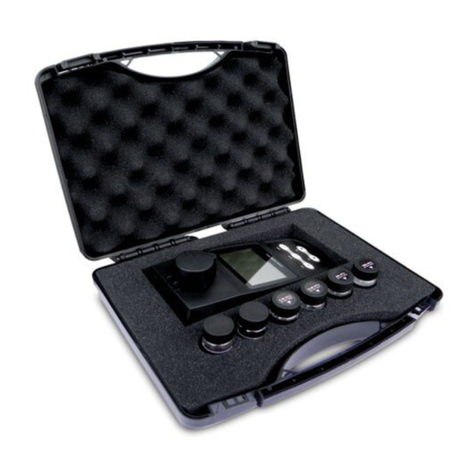TPI 717 User manual

717
Combustion Efficiency Analyzer
The Value LeaderTM
www. .com information@itm.com1.800.561.8187

Contents
Introduction.................................................. 1
General Overview............................................... 1, 2
Instrument Overview........................................... 3 ~ 7
Front View............................................. 3
Keypad................................................. 4
Back View............................................. 5
Side Views............................................ 6
Top View............................................... 7
Basic Analyzer Functions...................................... 8, 9
Analyzer Batteries................................... 8
Turning The Analyzer On & Fuel Selection.. 8, 9
Turning The Analyzer Off........................... 9
Activating The Backlight........................... 9
Combustion Analysis Overview.............................. 10
Combustion Analyzer Mode.................................. 11 ~ 19
Combustion Test Procedure....................... 11 ~ 19
Typical Test Locations.............................. 13 ~ 15
Combustion Analysis Displays.................... 17 ~ 18
Typical Test Results................................ 19
Thermometer Mode........................................... 20
Manometer Mode............................................. 21
Let By Pressure Test Mode.................................. 22, 23
Setting Date & Time.......................................... 24
Storing Data................................................... 25
Recalling Data................................................ 26
Printing Data.................................................. 27, 28
Specifications................................................ 29, 30
Calibration & Service....................................... 31
Warranty...................................................... 31
Appendix A General Maintenance & Function Tests........... 32~ 34
Appendix B A773 Sulfur Filter Installation & Maintenance. 35, 36
Appendix C Error Codes and Troubleshooting.................. 37, 38
Appendix D Field Sensor Replacement........................ 39 ~ 42
Appendix E Technical Notes..................................... 43
Appendix F Testing for Carbon Monoxide in Ambient Air.... 44
Appendix G Carbon Monoxide Limits in Ambient Air Chart.. 45
Appendix H Carbon Monoxide Facts............................ 46
Appendix I Battery Replacement................................ 47
www. .com information@itm.com1.800.561.8187

Introduction
Thank you for purchasing TPI brand products. The TPI 717 combus-
tion analyzer is a state of the art, easy to use analyzer designed not
only to display and calculate the required readings from a flue but also
to cover most of the other measurements associated with combustion.
The instrument is ruggedly constructed and comes with a 3 Year unit
and 2 Year sensor Guarantee.
General Overview
The TPI 717 combustion analyzer uses field replaceable state of the art
electrochemical sensors. This sensor technology provides the longest
lasting, most accurate and reliable means for performing combustion
tests. The sensors in your analyzer will need to be replaced periodically
and calibration is recommended once every year.
Electrochemical sensors by nature are always active. Therefore the
time the analyzer is off and not being used must be taken into account
when determining sensor life. The sensors in your analyzer are war-
ranted for two years. This warranty does not cover sensors damaged
through misuse of the analyzer.
You should keep the batteries of your 717 fresh so power is constantly
being supplied to your sensors.
The following guidelines will help prevent damage to your sensors:
Always use the mini pump filter when testing flue gases.
Always periodically check and replace the mini pump filter as needed.
Always make sure the in-line filter / water trap is installed properly.
Always periodically check and replace the in-line filter as needed.
Always remove water or condensation from the inside of the in-line fil-
ter / water trap assembly prior to performing tests.
Always use the optional oil filter (p/n A773) when performing tests on
oil burning equipment.
1
www. .com information@itm.com1.800.561.8187

General Overview (Continued)
Never over saturate your sensors by performing tests on equipment
with gas levels beyond the capability of you analyzer.
Always keep the A796 water trap / filter assembly clean and replace the
filter as necessary. Replacement filter part number is A762F.
This manual will guide you through the functions of the TPI 717 which
will give you many years of reliable service.
Your TPI 717 Flue Gas Analyzer comes complete with the following
standard accessories:
•TPI 717 Instrument
•Rubber Boot (A765)
•Soft Carrying Case (A768)
•Flue Sampling Probe (A770)
•In-Line Filter assembly installed on Flue probe (A796)
• Temperature Probe (GK11M)
•Mini Pump Protection Filter Assembly and spare filters (A763)
•Exhaust Spigot (removable) (A764)
•Instruction Manual
( ) Denotes part number
Your TPI 717 Flue Gas Analyzer has the following options available:
•Infrared printer (A740)
•Spare In-Line Filter (A762F is a package of 5 filters)
•Field replaceable smart CO sensor (A760S)
•Field replaceable smart O2 sensor (A761S)
2
www. .com information@itm.com1.800.561.8187

Instrument Overview
Front View
Rubber Boot Protects the instrument from accidental damage
Display Large 3 Parameter Backlit LCD Display
Battery Condition Icon Shows condition of batteries.
Keypad Selects all available functions
Selected Fuel Type N GAS, LPG, LIGHT OIL, HEAVY OIL, OPT 1
(Bituminous Coal), OPT 2 (Anthracite Coal),
OPT 3 (Coke), OPT 4 (Butane), OPT 5 (Wood),
OPT 6 (Bagasse)
Rubber
Boot
LCD
Display
Keypad
Battery
Condition
Icon
Selected
Fuel Type
NOTE: When selecting oil as fuel be sure to use the optional
oil filter (A773) or readings could become erratic. See
Appendix E for installation instructions.
3
www. .com information@itm.com1.800.561.8187

Keypad
Scrolls through selectable fuels (see page 8 )
Switches between ºC and ºF (see pages 18 & 21)
Scrolls through selectable pressure units
Moves up through the Stored Data Addresses
Zeroes pressure reading (See page 21)
Moves down through the Stored Data Addresses
Scrolls through Combustion Analysis Displays (See 17& 18)
Turns ch2 temperature ON/OFF (see page 20)
Allows you to choose a Stored Data Address
Sends stored data to a separate infrared printer (see pg 25)
Allows you to view stored data on the display (see pg 24)
Stores readings to memory (see pg 23)
Scrolls through and selects analyzer functions (see 20~22)
Turns Backlight ON and OFF (see 9)
Turns the instrument ON and OFF (see pages 8 & 9)
Func
4
www. .com information@itm.com1.800.561.8187

Back View
Sample and Pressure Inlet Ports: Connection for Flue Probe
(see pages 7 & 11)
Connection for Mini Pump Protection
Filter (see pages 7 & 11)
Connection for pressure tubing
(see pages 7 & 21)
Calibration and Information Label: Displays calibration information and
serial number
Battery Compartment: Holds 3 AA Alkaline Batteries
Rubber Boot: Protects the instrument
Smart Sensor Access: For field replaceable sensors
(See appendix L)
Calibration and
Information
Label
Battery
Compartment
Rubber
Boot
Connection for
Mini Pump
Protection Filter
Connections for
Pressure Tubing
Sample and
Pressure Inlet
Ports
5
Access area to
smart sensors
www. .com information@itm.com1.800.561.8187

Side Views
Exhaust Port Port for connection of Exhaust Adapter
Infrared Window Window for sending stored data to IR Printer
(see page 25 )
Rubber Boot Protects the instrument from accidental damage
Exhaust
Port
Infrared
Window
Rubber
Boot
6
www. .com information@itm.com1.800.561.8187

Top View
T1
T2
P (+) P (-)
Gas Sampling Port
T1 Socket Connection for thermocouple plug on flue probe
(see page 11)
Connection for any 'K' type thermocouple probe
(see page 20)
T2 Socket Connection for ambient 'K' type thermocouple probe
(see page 11 )
Connection for any 'K' type thermocouple probe
(see page 20)
Gas Sample Port Connection for Mini Pump Protection Filter and Flue
Probe (see pages 7 & 11)
P (+) Port Connections for Pressure Tubing (see page 21)
P (-) Port
7
www. .com information@itm.com1.800.561.8187

BASIC ANALYZER FUNCTIONS
Analyzer Batteries
Your combustion analyzer is fitted with three AA size 1.5V alkaline batteries.
It is important to keep battery power to the sensors in your analyzer even
when it is not in use.
Your analyzer has a battery status indicator in the lower right corner of the
display. Battery status is determined as follows:
Indicates batteries are at full capacity.
Indicates batteries are at 2/3 capacity.
Indicates batteries are at 1/3 capacity. Replacement of batteries
should be considered soon.
Indicates batteries are very low and in need of replacement
immediately. See Appendix J for battery replacement instructions.
Turning The Analyzer On & Fuel Type Selection
Always: - Before turning on please ensure that the Mini Pump Protection
Filter assembly and the Temperature Sampling Probe complete with In-
Line Filter or the Tubing & In-Line Filter fare not connected to the Gas
Sample Port (see page 7)
The instrument MUST be turned on in a clean air environment as the initial
purge will set the Carbon Monoxide level to Zero and the Oxygen to 20.9%.
Press and hold down the Power Key and the TPI 717 will start its 30 second
countdown 'Purging...' will be displayed.
After the 717 has completed purging the fuel type can be selected by press-
ing the Up Arrow key. The selected fuel type is displayed in the lower left cor-
ner of the display. Selectable fuels are Natural Gas, LIGHT OIL, HEAVY OIL,
LPG, Bituminous Coal, Anthracite Coal, Coke, Butane, Wood (Dry), Bagasse,
and Wood Pellet.
After start up, several tests can be performed to ensure proper function of
the analyzer and flue probe. Please refer to Appendix A.
*NOTE: When selecting oil as fuel be sure to use the optional
oil filter (A773) or readings could become erratic. See
Appendix E for installation instructions.
8
www. .com information@itm.com1.800.561.8187

After the 30 second countdown the instrument is ready to take Flue,
Temperature, and Pressure readings and the default combustion display will
be displayed.
The 717 will auto power off if no keys have been pressed for 10 minutes and
the CO level is below 15ppm. Auto off can be disabled (see Appendix D). The
auto power off feature is always enabled upon power up.
The Scroll/Enter Key allows you to scroll through the combustion displays as
outlined on pages 17&18. The Func Key is used to select the 717 function
mode and allows you to set it to be a combustion analyzer, manometer, or
thermometer. In addition, the Func Key is used to access the date and time
display. See pages 20 through 24 for more information on the Func Key.
Turning The Analyzer Off
Always: - Before turning off return the instrument to a clean air environment
and allow the Carbon Monoxide level to return to below 15ppm and the
Oxygen level to return to 20.9% (± 0.3%) Press the Power Key to turn the
instrument off:- NOTE Should you attempt to turn the instrument Off and the
CO reading is above 15ppm then the instrument will remain On and a short
Beep will be heard. The Instrument can only be switched off if the CO is
below 15ppm
The instrument has an auto shut off after 10 minutes should no keys have
been pressed for this period and as mentioned above that the CO is below
15ppm. Should the CO be above 15ppm then the 10 minute auto shut off
countdown will not begin till the CO has gone below 15ppm. The auto power
off feature can be disabled. Please see Appendix D. The auto power off fea-
ture is always enabled upon power up.
Activating the Backlight
The display backlight can be activated at any time by pressing and holding
down the Func Key for approximately 2 seconds. The backlight will automati-
cally shut off after approximately 20 seconds to preserve battery life.
9
www. .com information@itm.com1.800.561.8187

COMBUSTION ANALYSIS OVERVIEW
Performing combustion analysis is very important to the overall safety and
efficiency of heating equipment. The following guidelines and descriptions are
generic and meant to provide you with a basic understanding of combustion
testing. TPI always recommends you contact the manufacturer of the device
under test, obtain information specific to the device, and follow the proce-
dures and safety guidelines for performing tests and affecting repairs.
In general, for most applications, flue gas samples should be taken prior to
the draft diverter or any other opening that allows room air to enter the sys-
tem. This prevents room air from mixing with gases in the flue and diluting
the test sample. To ensure accurate and consistent combustion tests, it is
important gas and temperature samples be taken at the same location. This is
easy with the TPI flue probe because the temperature sensor is an integral
part of the probe.
Prior to taking a sample, the device under test should be on and operating.
Putting the flue probe in the sample area prior to starting the device may
cause saturation of the sensors due to the higher initial concentration of car-
bon monoxide that may be encountered upon start up. If this happens, allow
your analyzer to purge in fresh air until the carbon monoxide level returns to
0 ppm and the oxygen level returns to 20.9%. This may take more than an
hour depending on how saturated the sensors are.
The figures on pages 13 through 15 show locations for performing tests on
commonly encountered equipment. Remember to consult with the manufac-
turer of the device under test for specific test information.
Pressing the Func Key enables access to the different functions available on
the 717. The default function is Combustion Analyzer. Other available func-
tions are: Thermometer, Manometer/Tightness Test, and Date / Time display.
Refer to the Appendix G “Technical Notes” for additional information.
10
www. .com information@itm.com1.800.561.8187

Combustion Analyzer (Default Start Up Mode)
COMBUSTION TEST PROCEDURE
Note: It is recommended you perform routine general maintenance on your
analyzer to ensure proper function. Please refer to Appendix A for general
maintenance schedule and function tests.
1. Turn the 717 on in fresh air as outlined on page 8. After the initial purge
cycle the 717 will default to combustion analyzer mode and combustion dis-
play 1 will be seen.
• Combustion Display 1 (Default Start Up Display)
• Displays Oxygen (O2) reading in percent (%)
• Displays Carbon Monoxide (CO) in parts per million (ppm)
2. Connect the Mini Pump Protection Filter assembly and Flue Probe Tubing
complete with In-Line Filter to the Gas Sample Port and the 'K' Type
Thermocouple Plug from the Flue Probe into Thermocouple (T1) Socket. The
GK11M ambient air temperature probe is connected to the (T2) socket. (See
below & page 7)
WARNING: - Ensure the 'K' type thermocouple probes are inserted into the
sockets correctly (see page 7). The plugs are polarity marked and forcing the
plug into the socket the wrong way may result in damage to the
instrument.
Mini Pump
Protection Filter
Assembly
Ambient Air
Connection (T2)
GK11M Probe
Flue Probe
Connection (T1)
In-line Filter
Assembly
Flue Probe
Tubing
11
www. .com information@itm.com1.800.561.8187

IMPORTANT: Prior to taking a sample, the device under test should be on and
at operating temperature. Putting the flue probe in the sample area prior to
starting the device may cause saturation of the sensors due to the higher
initial concentration of carbon monoxide that may be encountered upon
start up. If this happens, allow your analyzer to purge in fresh air until the
carbon monoxide level returns to 0 ppm and the oxygen level returns to
20.9%. This may take more than an hour depending on how saturated the
sensors are.
3. Drill a 1/4 inch hole into the flue of the device under test. For most applica-
tions, flue gas samples should be taken prior to the draft diverter or any
other opening that allows room air to enter the system. This prevents room
air from mixing with gases in the flue and diluting the test sample.
It is important to use manufacturers recommended test locations whenever
possible.
Refer to the figure below for calculating the sample hole location.
The figures on the following pages show typical test locations on commonly
encountered equipment.
12
www. .com information@itm.com1.800.561.8187

TYPICAL TEST LOCATIONS
Atmospheric Gas Fired Fan Assist Boiler / Furnace
Typical Test Locations
Figure 1
It is important to use manufacturers recommended test locations
whenever possible.
13
www. .com information@itm.com1.800.561.8187

Condensing Boiler / Furnace
Typical Test Locations
Figure 2
TYPICAL TEST LOCATIONS
It is important to use manufacturers recommended test locations
whenever possible.
14
www. .com information@itm.com1.800.561.8187

Test all exhaust ports at the
top of the heat exchanger.
Atmospheric Forced Air Furnace
Typical Test Locations
Figure 3
TYPICAL TEST LOCATIONS
It is important to use manufacturers recommended test locations
whenever possible.
15
www. .com information@itm.com1.800.561.8187

4. Insert the flue probe into the sample hole of the device under test. The
probe tip should be in the middle of the flue pipe or exhaust stream.
Ensure the In-Line Filter / Water Trap hangs below the analyzer in the proper
vertical position when readings are being taken. Failure to comply reduces
the effectiveness of the water trap and may result in damage to the instru-
ment. Refer to the pictures below for correct and incorrect use.
WARNING: - Should the CO reading rise above 2,000ppm a continuous series
of Alarm Beeps will be heard. The Probe should immediately be disconnected
from the instrument and the instrument returned to a clean air environment.
This Alarm alerts the user that there is a high concentration of CO, and this
procedure will protect the sensors within the instrument. The alarm level can
be changed. Please see Appendix D
Make sure to check the water trap periodically during testing to ensure it
does not fill with condensate and empty it as necessary. If the filter begins to
fill during a test, open the lid and empty out the condensate. After closing the
lid, allow readings to stabilize again.
IMPORTANT:The water trap is fitted with a water block filter (p/n A794W) in
the lid to prevent water from flowing down into the pump. If the water trap
fills the water block filter will stop the flow to the analyzer and FLO ERR will
display. The water trap should be emptied immediately if this happens. The
water block filter may need to be dried out or replaced before testing can
resume.
16
www. .com information@itm.com1.800.561.8187

5. Allow the readings to stabilize. Multiple combustion analysis displays are
available to provide the various test results. Use the Scroll/Enter Key to move
through the various combustion displays.
• Combustion Display 1 (Default Start Up Display)
• Displays Oxygen (O2) reading in percent (%)
• Displays Carbon Monoxide (CO) reading in parts per million
(ppm)
• Pressing the Down Arrow Key will toggle between Gross &
Net Efficiency (Note: Gross Efficiency is used in the USA.
Refer to Appendix G, Note 4 for additional information)
• Pressing the UP Arrow Key will toggle between available fuels
(see page 8)
Pressing the Scroll Enter key changes the display:
• Combustion Display 2
• Displays Oxygen (O2) reading in percentage (%)
• Displays Carbon Dioxide (CO2) calculation in percentage
(%)
• Displays calculated CO/CO2 (Ratio) figure. The 717 calcu-
lates this number by first converting the CO2 measurement
from percentage to ppm. The formula for this conversion is:
CO2ppm=(CO2%*10,000). This ratio is not used in any other
calculations. 10,000ppm = 1%
Pressing the Scroll Enter key changes the display:
• Combustion Display 3
• Displays Temperature reading on input T1
• Displays Carbon Monoxide (CO) reading in parts per million
(ppm)
• Displays Combustion Efficiency (Eff.) in percentage (%)
• Pressing the Down Arrow Key will toggle between Gross &
Net Efficiency (Note: Gross Efficiency is used in the USA.
Refer to Appendix G, Note 4 for additional information)
Pressing the Scroll Enter key changes the display: (Next Page)
17
www. .com information@itm.com1.800.561.8187

• Combustion Display 4
• Displays Oxygen (O2) reading in percent (%)
• Displays Carbon Monoxide (CO) reading in parts per mil-
lion (ppm)
• Displaye Excess Air (XAir) in percentage (%)
The formula for CO air free is: COairfree = (20.9/20.9 - O2 meas.) x CO meas.
Pressing the Scroll Enter key changes the display:
• Combustion Display 5
• • Displays CO air free (-CF-)
CO air free takes into account excess air (make up air) and
factors this out of the displayed reading. Some systems inject
extra air to ensure complete combustion. This can dilute the
CO sample resulting in a low CO reading when the standard
CO display is being read.
This display should be used if the manufacturer specifications are stated
as CO air free. If it is used on a system that is not specified in CO air free
the displayed reading may appear abnormally high as compared to the
manufacturer specification.
Pressing the Scroll Enter key again will make the display return to combus-
tion display 1 (Default display)
6. During a combustion test you can save, print, and send data to a comput-
er. See pages 25 through 31. Allow readings to stabilize before saving or
printing the data. Refer to page 19 for typical test results.
7. Pressure measurements can be made during a combustion test if required.
Refer to page21.
8. After the test is complete, remove the flue probe from the test location and
allow the analyzer to purge in a fresh air environment with the probe
attached. Make sure the analyzer purges to below 15ppm. Never remove the
battery to turn the analyzer off before the purge is complete. Refer to page 9
for complete instructions.
18
www. .com information@itm.com1.800.561.8187
Table of contents
Other TPI Measuring Instrument manuals
Popular Measuring Instrument manuals by other brands
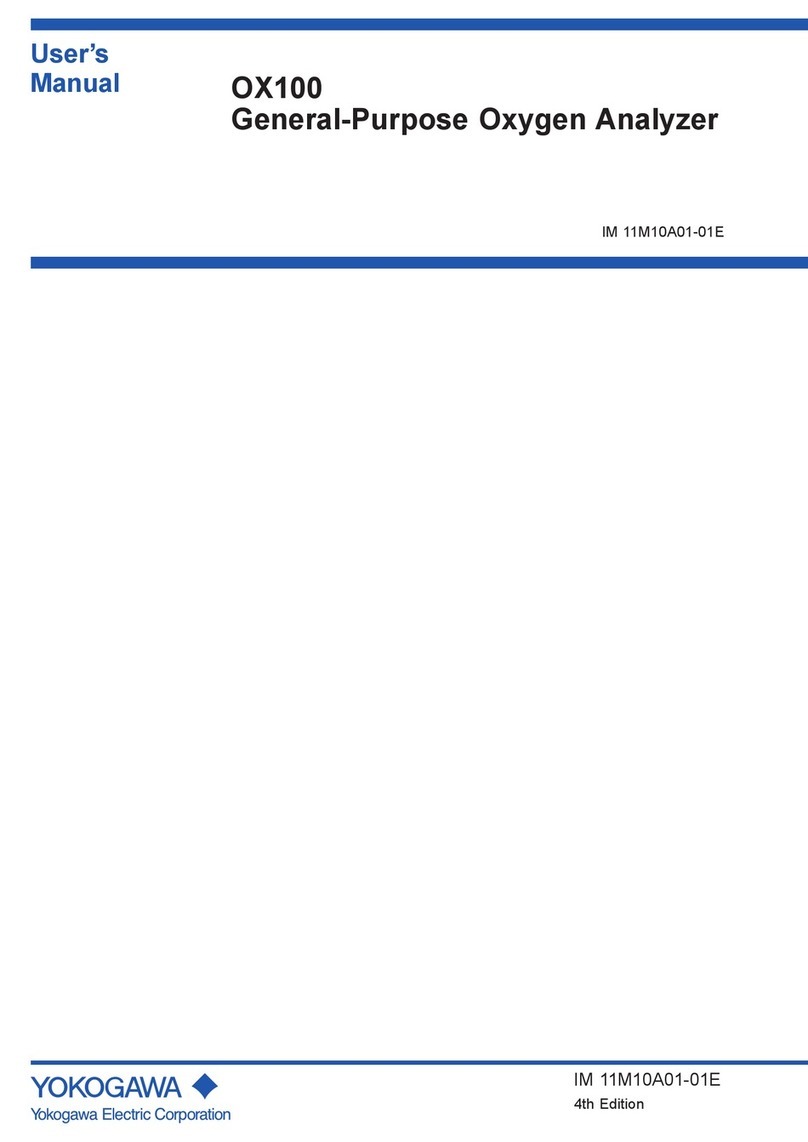
YOKOGAWA
YOKOGAWA OX100 user manual
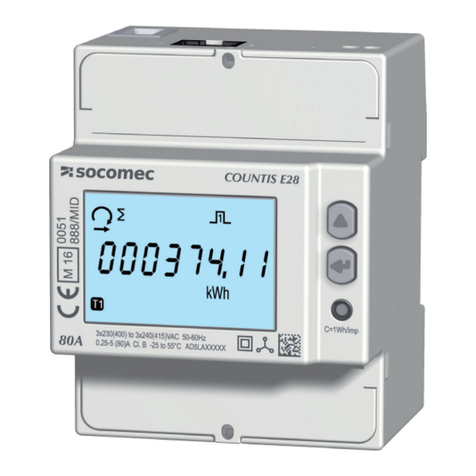
socomec
socomec COUNTIS E27 instruction manual
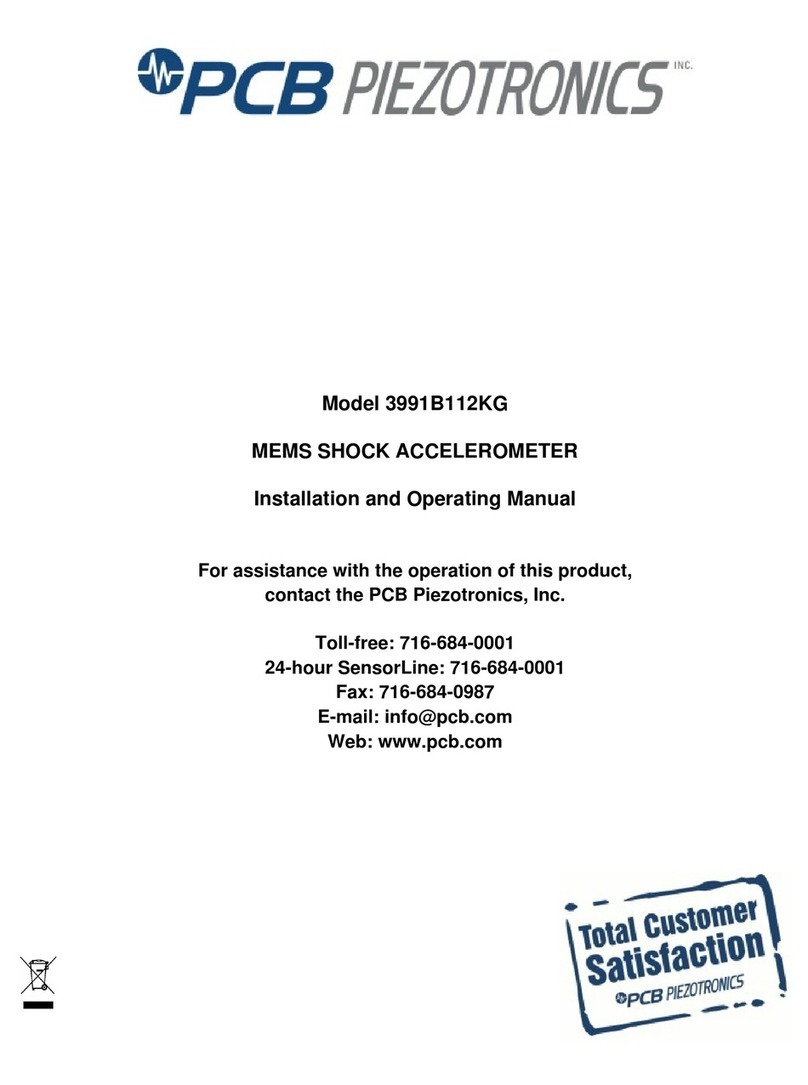
PCB Piezotronics
PCB Piezotronics 3991B112KG Installation and operating manual
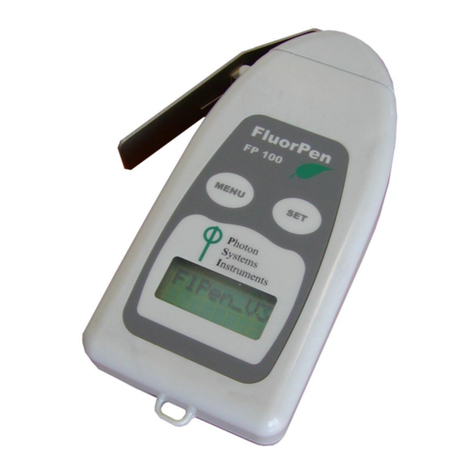
PSI
PSI FluorPen FP 100 Operation manual
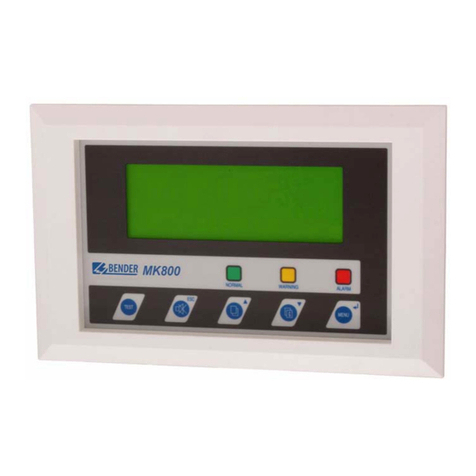
Bender
Bender COMTRAXX MK800 operating manual

EUTECH INSTRUMENTS
EUTECH INSTRUMENTS ?lpha-pH550 instruction manual
